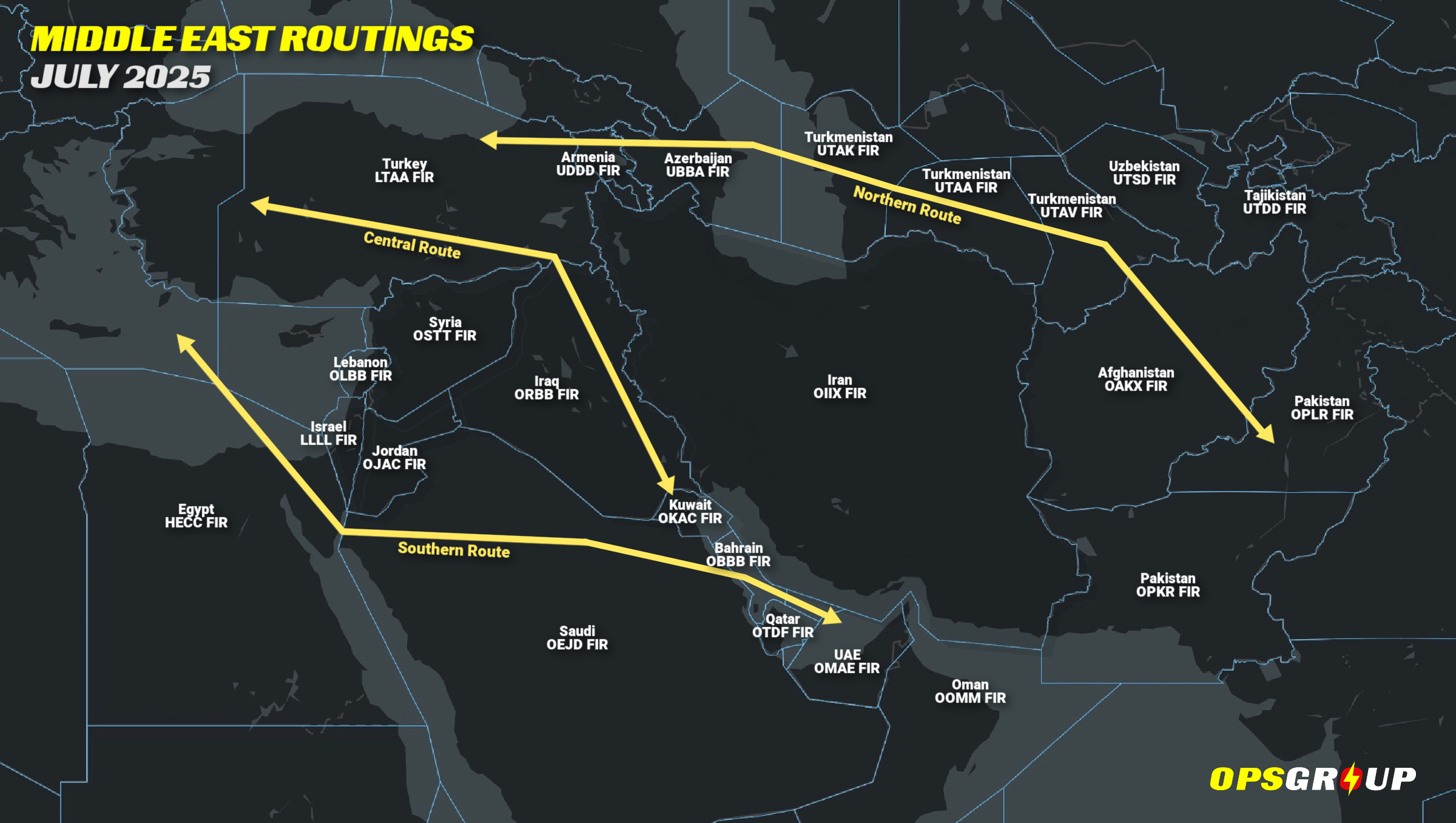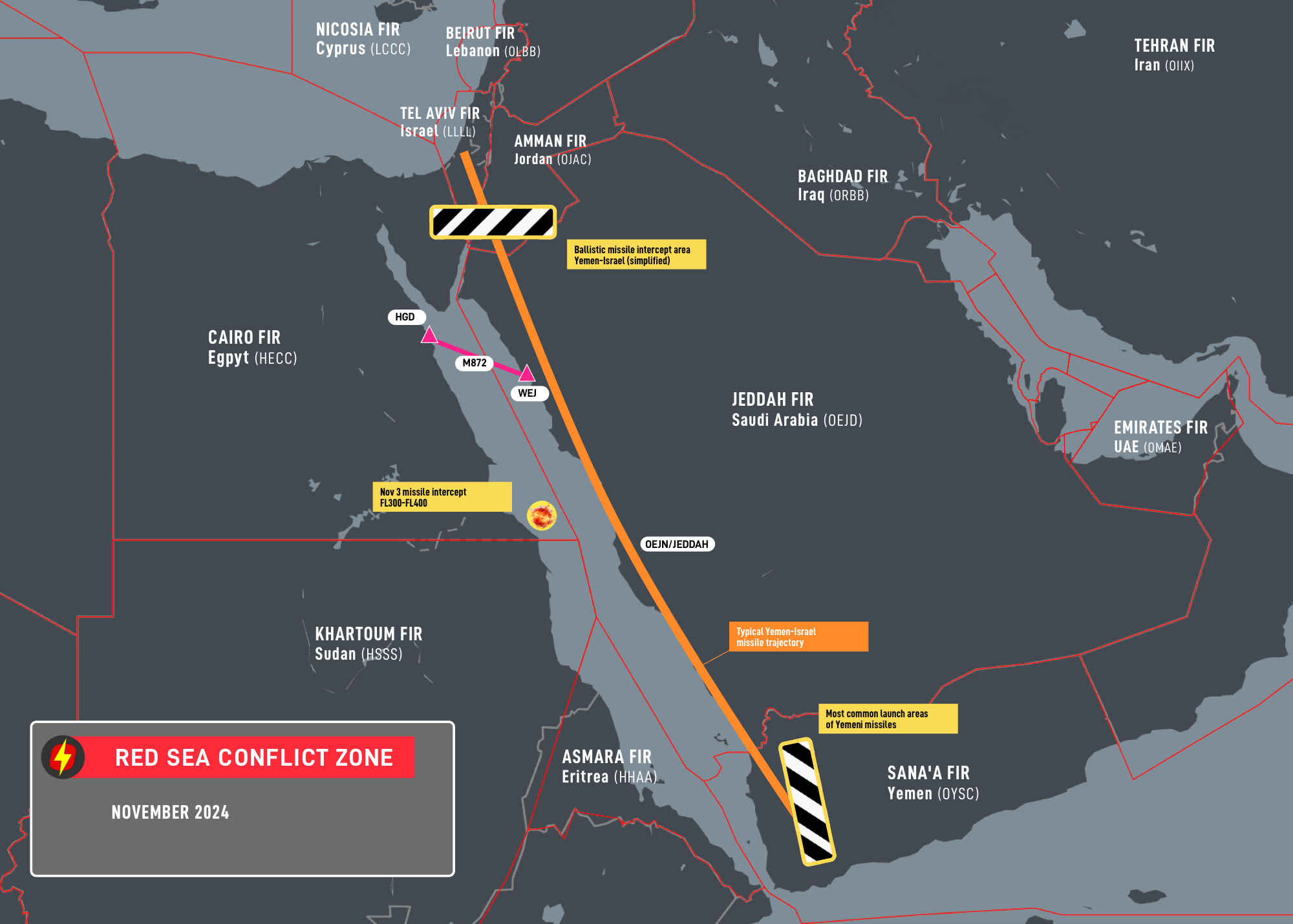Saudi Arabia
Risk Level: Two - Danger exists
[ about risk levels ]
July 2025: The ceasefire between Israel and Iran has held so far. All airspace in the region has largely reopened, but the corridor between Israel and Iran remains high risk if the conflict resumes.
See OPSGROUP Briefing: Middle East airspace situation – June 2025

The primary risk is from spillover from the Israel/Iran conflict in the north of the country; and from Houthi drone and missile attacks on Israel, shipping in the Red Zea, and prior attempts on airports across the country (OERK/Riyadh and OEJN/Jeddah airports have been targeted in the past) but particularly near the border with Yemen.
Prior to the June 2025 conflict between Israel and Iran, several countries already had airspace warnings in place for Saudi Arabia. Since 2023, risks to aircraft operating over the Sinai Peninsula and the Red Sea have increased due to the conflict in Israel/Gaza. There have been several incidents of missiles and drones launched from Yemen targeting Israel. Some have been shot down over the Red Sea, others have landed on the Egypt/Israel border. A missile intercept incident near Jeddah in Nov 2024 (observed at close proximity by transiting air crew) highlighted the risk to civil aviation, and made it clear that this area is an extension of the Israeli conflict. Many Europe-Asia Middle East routes fly over this area. A Special Briefing on this risk is available in your members Dashboard (Special Briefings, Red Sea Conflict Zone).

Also be aware of ESCAT procedures if entering the OEJD/Jeddah FIR – you can find those here.
Major events:
June 2025: EASA issues CZIB warning of spillover risk in the airspace of Egypt and Saudi Arabia from the conflict between Israel and Iran.
Nov 2024: Missile intercept in close proximity to transiting aircraft near Jeddah.
Oct 2023: Cruise missiles and drones launched from Yemen targeting Israel. Some shot down over the Red Sea, others landing on Egypt/Israel border.
Sep 2023: Houthi drone attacks near the Yemen-Saudi border.
Apr-Oct 2022: All parties in the Yemeni conflict agree a ceasefire.
2020-2022: Frequent Houthi drone and rocket attacks targeting OEAH/Abha and OEGN/Jizan airports along the Yemeni-Saudi Border.
See OPSGROUP Briefing: Middle East airspace situation – June 2025

The primary risk is from spillover from the Israel/Iran conflict in the north of the country; and from Houthi drone and missile attacks on Israel, shipping in the Red Zea, and prior attempts on airports across the country (OERK/Riyadh and OEJN/Jeddah airports have been targeted in the past) but particularly near the border with Yemen.
Prior to the June 2025 conflict between Israel and Iran, several countries already had airspace warnings in place for Saudi Arabia. Since 2023, risks to aircraft operating over the Sinai Peninsula and the Red Sea have increased due to the conflict in Israel/Gaza. There have been several incidents of missiles and drones launched from Yemen targeting Israel. Some have been shot down over the Red Sea, others have landed on the Egypt/Israel border. A missile intercept incident near Jeddah in Nov 2024 (observed at close proximity by transiting air crew) highlighted the risk to civil aviation, and made it clear that this area is an extension of the Israeli conflict. Many Europe-Asia Middle East routes fly over this area. A Special Briefing on this risk is available in your members Dashboard (Special Briefings, Red Sea Conflict Zone).

Also be aware of ESCAT procedures if entering the OEJD/Jeddah FIR – you can find those here.
Major events:
June 2025: EASA issues CZIB warning of spillover risk in the airspace of Egypt and Saudi Arabia from the conflict between Israel and Iran.
Nov 2024: Missile intercept in close proximity to transiting aircraft near Jeddah.
Oct 2023: Cruise missiles and drones launched from Yemen targeting Israel. Some shot down over the Red Sea, others landing on Egypt/Israel border.
Sep 2023: Houthi drone attacks near the Yemen-Saudi border.
Apr-Oct 2022: All parties in the Yemeni conflict agree a ceasefire.
2020-2022: Frequent Houthi drone and rocket attacks targeting OEAH/Abha and OEGN/Jizan airports along the Yemeni-Saudi Border.
Current warnings list :
| Source | Reference | Issued | Valid to | |
|---|---|---|---|---|
| EASA | Information Note | 31 Jul 2025 | 31 Oct 2025 | |
| Italy | Notam LIRR E1545/25 | 25 Jun 2025 | 26 Sep 2025 | |
| France | AIC 15/24 | 29 Sep 2023 | Ongoing | |
| Canada | AIC 21/25 | 10 Aug 2023 | Ongoing | |
| USA | FAA Information Note Saudi Arabia/Yemen | 17 Mar 2022 | Ongoing | |
| Saudi Arabia | Notam OEJD W0120/21 | 28 Jan 2021 | Ongoing |
Source: EASA
Reference: Information Note
Issued: 31-Jul-25, valid until: 31 Oct 2025
Plain English: Operators should take potential risk into account in the airspace of Southern Red Sea.
Information Note on threat and risk situation in the airspace of Southern Red Sea.
Airspace affected:
Airspace above the Southern Red Sea in FIR Jeddah - OEJD, FIR Asmara - HHAA and FIR Sanaa - OYSC south of latitude N 18°00’00 and airspace above the Bab al-Mandeb Strait FIR Addis Ababa - HAAA, all flight levels.
Civil air operators are advised to take potential risk into account in their risk assessment and routing decisions.
Airspace affected:
Airspace above the Southern Red Sea in FIR Jeddah - OEJD, FIR Asmara - HHAA and FIR Sanaa - OYSC south of latitude N 18°00’00 and airspace above the Bab al-Mandeb Strait FIR Addis Ababa - HAAA, all flight levels.
Civil air operators are advised to take potential risk into account in their risk assessment and routing decisions.
Source: Italy
Reference: Notam LIRR E1545/25
Issued: 25-Jun-25, valid until: 26 Sep 2025
Plain English: Caution to Italian operators in the OEJD/Jeddah FIR where ATC could apply ESCAT procedures with short notice.
ITALIAN AIR CARRIERS AND CAPTAINS OF AIRCRAFT IN CHARGE OF AIR� SERVICES OPERATED BY CARRIERS HOLDING AN OPERATING LICENSE� ISSUED BY ITALY, WHETHER THEY ARE CONTRACTUAL CARRIERS AND/OR� OPERATING CARRIERS, OR PERFORMING AIR SERVICES THROUGH A WET� LEASE OR A CODESHARE AGREEMENT AS WELL AS FOR ANY FLIGHT MADE� WITH AN AIRCRAFT REGISTERED IN ITALY WHEN PLANNING FLIGHT� OPERATIONS WITHIN JEDDAH FIR (OEJD) ARE RECOMMENDED TO EXERCISE� ENHANCED CAUTION AND TO FOLLOW INSTRUCTIONS FROM SAUDI� AUTHORITIES PROVIDING AIR TRAFFIC MANAGEMENT PAYING PARTICULAR� ATTENTION TO RESTRICTIONS OR INTERDICTIONS PUBLISHED WITH VERY� SHORT NOTICE AND TO EASA SAFETY DIRECTIVES.
Source: France
Reference: AIC 15/24
Issued: 29-Sep-23, valid until: Ongoing
Plain English: French operators should exercise caution in the southwest of the OEJD/Jeddah FIR where ATC could apply ESCAT procedures.
From 29/09/2023 and until further notice, pilots in command of aircraft performing air services mentioned in paragraph 1.1 are requested :
- to exercise great caution in the southwest of JEDDAH FIR (OEJD) where the airports of Abha (OEAB), Jazan (OEGN), Nejran (OENG), Sharurah (OESH), Wadi Al Dawasir (OEWD), Al Bahah (OEBA) and Bisha (OEBH) are located, in which ESCAT (Emergency Security Control of Air Traffic) may be activated by NOTAM from the Saudi authorities, and
- to monitor the appropriate ATC frequencies and to comply strictly with the instructions given by the Saudi authorities providing air traffic services.
- to exercise great caution in the southwest of JEDDAH FIR (OEJD) where the airports of Abha (OEAB), Jazan (OEGN), Nejran (OENG), Sharurah (OESH), Wadi Al Dawasir (OEWD), Al Bahah (OEBA) and Bisha (OEBH) are located, in which ESCAT (Emergency Security Control of Air Traffic) may be activated by NOTAM from the Saudi authorities, and
- to monitor the appropriate ATC frequencies and to comply strictly with the instructions given by the Saudi authorities providing air traffic services.
Source: Canada
Reference: AIC 21/25
Issued: 10-Aug-23, valid until: Ongoing
Plain English: Canadian operators advised caution in the OEJD/Jeddah FIR due to potential risk from anti-aviation weaponry and military operations; also due to short notice ESCAT rules in airspace next to Yemen.
Level 1 (Information)
SECURITY – HAZARDOUS SITUATION IN SAUDI ARABIA.
Canadian Air Operators and owners of aircraft registered in Canada are advised to take all potential risk information into account in their risk assessment routing decisions within FIR Jeddah (OEJD). Potential risk from anti-aviation weaponry and military operations. ESCAT (Emergency Security Control of Air Traffic) rules may be activated by NOTAM from the Saudi authorities in the southwest area of FIR OEJD.
SECURITY – HAZARDOUS SITUATION IN SAUDI ARABIA.
Canadian Air Operators and owners of aircraft registered in Canada are advised to take all potential risk information into account in their risk assessment routing decisions within FIR Jeddah (OEJD). Potential risk from anti-aviation weaponry and military operations. ESCAT (Emergency Security Control of Air Traffic) rules may be activated by NOTAM from the Saudi authorities in the southwest area of FIR OEJD.
Source: USA
Reference: FAA Information Note Saudi Arabia/Yemen
Issued: 17-Mar-22, valid until: Ongoing
Plain English: There is a potential risk to ops at Saudi airports and for overflights of the OEJD/Jeddah FIR due to Houthi drone and missile attacks from Yemen and the associated defensive operations.
Title: FAA Information Note - Saudi Arabia/Yemen: Houthi UAS Attack in Riyadh.
Click the link for full text.
Click the link for full text.
Source: Saudi Arabia
Reference: Notam OEJD W0120/21
Issued: 28-Jan-21, valid until: Ongoing
Plain English: ESCAT rules may be activated at any time in the south part of the OEJD/Jeddah FIR, when Saudi air defenses are repelling drone and missile attacks from Yemen. Operators will likely be given a change of route directly out of the airspace, or will be directed to land at the nearest airport.
DUE TO CONFLICT IN YEMEN BETWEEN LEGITIMATE GOVERNMENT AND THE HOUTHI MILITIA SUPPORTED BY IRANIAN REGIME ESCAT IS ACTIVATED IN THE SOUTH PART OF JEDDAH FIR FLYING RULES AND INFORMATION ON AVAILABLE ATS ROUTES ARE DESCRIBED IN AIP SUP 02/2021. PILOTS SHALL KEEP LISTENING TO THE APPROPRIATE ATC FREQUENCIES AND SHALL ADHERE STRICTLY TO ATC INSTRUCTIONS WHEN FLYING TO/FROM THE SOUTHERN AIRPORTS DUE TO DEFENSE RESPONSES THAT MAY OCCUR. IN ADDITION, SAUDI ARABIA IS PUTTING IN PLACE MEASURES TO MITIGATE RISK THAT MIGHT RESULT FROM LIMITED LONG-RANGE MISSILES AND UNMANNED AIRCRAFT SYSTEM CAPABILITIES THAT MAY TARGET AIRPORTS WITHIN JEDDAH FIR. OPERATORS MAY CONSIDER THIS INFORMATION WHEN CONDUCTING RISK ASSESSMENT.
28 JAN 14:00 2021 UNTIL PERM. CREATED: 28 JAN 14:01 2021
28 JAN 14:00 2021 UNTIL PERM. CREATED: 28 JAN 14:01 2021
